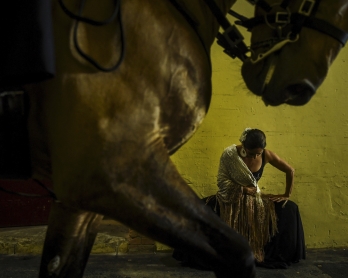The women photographers series: Angela Weiss
When did your passion for photography begin?
I grew up in a tiny village in Germany, and from early on in my childhood, I was fascinated by books that featured the "pictures of the year." I worked in a bookstore when I was a teenager, and used my salary to buy those books. But nothing really preordained a career in photography for me.
My parents are both scientists. My dad did have a Minolta camera that he would use to photograph and he taught me the basics -- aperture, shutter speed, etc -- but there was no "aha" moment with him. I do have an uncle who is a well-known portrait and documentary photographer in Berlin, and I remember going to an exhibition he staged with some of his colleagues. I was super impressed.
Also when I was young, I would stay up all night in Germany to watch the Oscars. I was fascinated by the glamour of Hollywood. I eventually moved about 20 years ago to Las Vegas -- the only way I could stay in the United States was to get a student visa, and so I went to college to study photography.
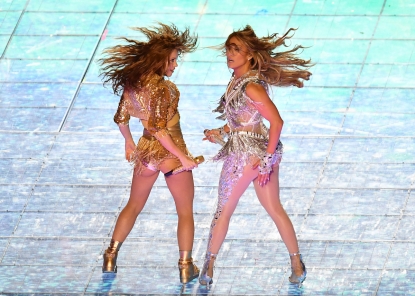 US singer Jennifer Lopez (R) and Colombian singer Shakira (L) perform during the halftime show of Super Bowl LIV between the Kansas City Chiefs and the San Francisco 49ers at Hard Rock Stadium in Miami Gardens, Florida, on February 2, 2020 (AFP / Angela Weiss)
US singer Jennifer Lopez (R) and Colombian singer Shakira (L) perform during the halftime show of Super Bowl LIV between the Kansas City Chiefs and the San Francisco 49ers at Hard Rock Stadium in Miami Gardens, Florida, on February 2, 2020 (AFP / Angela Weiss)
That was the first time I spent any time in a darkroom developing my own photos. I liked to go take pictures at Vegas shows and concerts. I loved the fast-paced environment of those events, and then the calm of working in the darkroom to bring those actions, frozen on film, to life.
I knew I wanted to do something creative with my life, something when each day would be different. I decided on photography -- I didn't know exactly which bit of the medium to pursue, but I went with what was in front of me: entertainment.
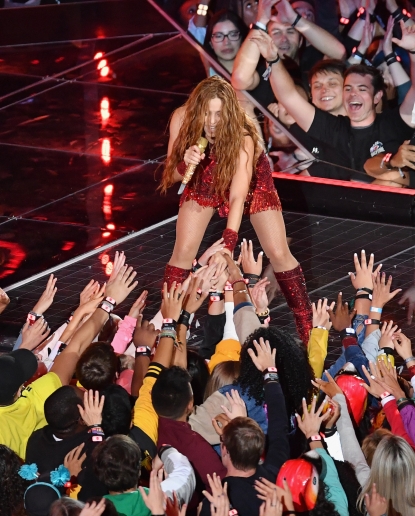 Colombian singer Shakira performs during the halftime show of Super Bowl LIV between the Kansas City Chiefs and the San Francisco 49ers at Hard Rock Stadium in Miami Gardens, Florida, on February 2, 2020. (Photo by Angela Weiss / AFP) (AFP / Angela Weiss)
Colombian singer Shakira performs during the halftime show of Super Bowl LIV between the Kansas City Chiefs and the San Francisco 49ers at Hard Rock Stadium in Miami Gardens, Florida, on February 2, 2020. (Photo by Angela Weiss / AFP) (AFP / Angela Weiss)
In 2001, when I really started learning the business, film and digital photography still coexisted. So I learned the traditional way of developing film -- shooting, making prints and framing them -- as well as the basics of the digital craft.
I'm really glad that I learned the old methods -- it's a moment of calm and you are just focused on your work. It really helps me now to have that discipline. It is more in-depth. Images are much harder to manipulate in the darkroom. With film, you have to shoot as if you were going to print them right away. I would take photos of show girls and dancers on stage and wonder: 'Did I capture the moment or not?'
And then I would go into the darkroom and it would be peaceful in there and... and you would only get your answer at the end of the developing process.
Now, it's practically the inverse. Everything is instantaneous. We shoot, we upload, and images go to clients so quickly. Most of the time, you can't even really spend much time on each image, especially when it's breaking news or politics.
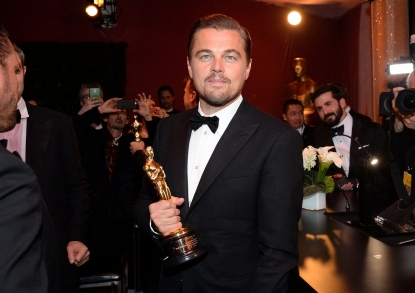 Actor Leonardo DiCaprio, winner of the Best Actor award for 'The Revenant,' poses with his Oscar at the 88th Annual Academy Awards Governors Ball on February 28, 2016 (AFP / Angela Weiss)
Actor Leonardo DiCaprio, winner of the Best Actor award for 'The Revenant,' poses with his Oscar at the 88th Annual Academy Awards Governors Ball on February 28, 2016 (AFP / Angela Weiss)
At AFP, for major events such as the Oscars or the Olympic Games, we file directly via ethernet cable to the editing desks from our cameras, and they are then sent to clients. That creates a lot of angst about whether the tech will work.
How did your career really take off?
My breakthrough moment? I sort of owe it all to... Madonna. In 2004, my girlfriend at the time got a job as a lighting technician for Madonna's Re-Invention World Tour. That's how I got an all-access pass to watch some of the shows.
I asked if it was ok to take some pictures. I had a pretty low-end digital camera at the time. Madonna's manager said yes -- but asked me to show them the pictures afterwards. I covered about eight shows across North America, and showed my photos to the dancers and the manager, and then the manager said, "I want to show them to Madonna."
When she came back to me, she told me Madonna wanted to use one of the shots for billboards and posters to promote the tour. They sent me a super-long contract that I could not understand -- I didn't know anything about rights or things like that. She did indeed buy one of my photos to use, and I bought my first car with the money! I was 25 years old.
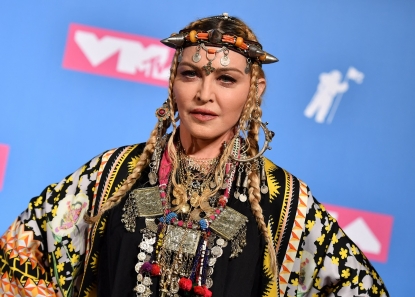 Madonna at the 2018 MTV Video Music Awards at Radio City Music Hall on August 20, 2018 in New York City (AFP / Angela Weiss)
Madonna at the 2018 MTV Video Music Awards at Radio City Music Hall on August 20, 2018 in New York City (AFP / Angela Weiss)
But I still had a lot to learn about the industry. I quickly realized there were a lot of talented people to compete with and that I needed to act quickly to secure my spot. I was planning to move to Los Angeles, and at that precise time, I got a call from Getty Images, and started working for them as a freelancer.
My life is suddenly what I had dreamed of as a kid: going to film premieres, concerts and award shows, all loaded with stars parading down red carpets.
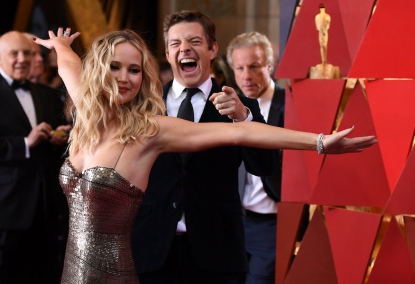 US actress Jennifer Lawrence arrives for the 90th Annual Academy Awards on March 4, 2018, in Hollywood, California (AFP / Angela Weiss)
US actress Jennifer Lawrence arrives for the 90th Annual Academy Awards on March 4, 2018, in Hollywood, California (AFP / Angela Weiss)
So what is it like being a celebrity photographer?
It's a very particular skill, and one that is very linked to the lives of the stars and the quality of the image. The bigger the star, the more unique the image -- the more money you make. Is the star getting a divorce? Or maybe a baby? Did the actress's dress rip? All these things matter.
Today, it's different -- everybody has a mobile phone and can snap a picture of a star at the right moment. It's a lot harder for freelancers.
But I don't think everyone is a photographer. You have to have a unique eye, a singular way of seeing things. You must catch something that others did not see. Today, if Madonna were to go on tour, there would be pictures of her from backstage taken by the manager, her makeup artist, the dancers -- any number of people. Who would need me to take photos?
One of my recent favorite photographs was taken at the Met Gala, one of the biggest social events of the year in New York, where Hollywood, the music world, and fashionistas all coalesce.
 (AFP / Angela Weiss )
(AFP / Angela Weiss )
The photographers are all shouting at the guests to pose this way and that. They want eye contact from the star, so it seems to a viewer that the subject is looking right at them.
For Lady Gaga to have looked right at me is almost a miracle, given the absolute chaos of the night. And then the light of someone's flash bulb illuminated her face. It gave the image more depth and made it more special.
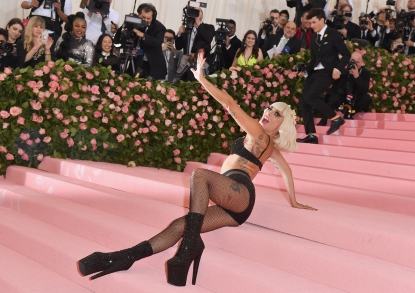 (AFP/ Angela Weiss)
(AFP/ Angela Weiss)
Please give me three words to define your work
I would choose diverse, organic and authentic. Diverse: I am shooting a lot of different things -- news, sports, entertainment. Organic: I really want to show moments as they are, without much post-production, just cropping and color correction. Authentic: I want things to be as real as possible.
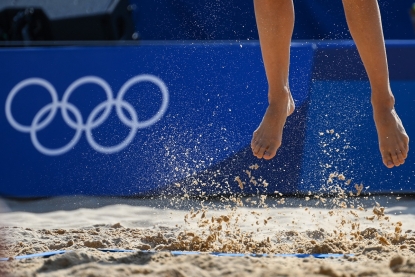 Germany's Laura Ludwig jumps for the ball in their women's preliminary beach volleyball pool F match between Switzerland and Germany in Tokyo on July 24, 2021. (AFP / Angela Weiss)
Germany's Laura Ludwig jumps for the ball in their women's preliminary beach volleyball pool F match between Switzerland and Germany in Tokyo on July 24, 2021. (AFP / Angela Weiss)What are your most memorable moments?
One of my favorite recent moments came in 2019. It was my first reporting assignment for AFP outside the United States. I went to Jamaica to shoot the women's soccer team, to mark their first trip to the World Cup. It was a really nice assignment -- for a few days, I watched them train, saw how they worked. The pitch was far from perfect -- it had holes -- and there were knots tied in the goal's netting to keep it together.
But to see a team achieve its goal through sheer dedication, when they had so many obstacles to overcome, was very special.
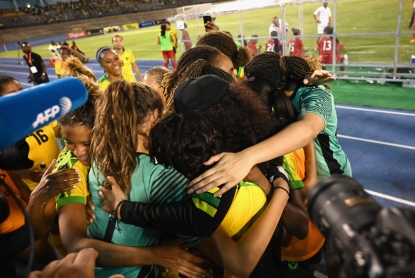 Jamaica's Women football team 'Reggae Girlz' on May 19, 2019 (AFP / Angela Weiss)
Jamaica's Women football team 'Reggae Girlz' on May 19, 2019 (AFP / Angela Weiss)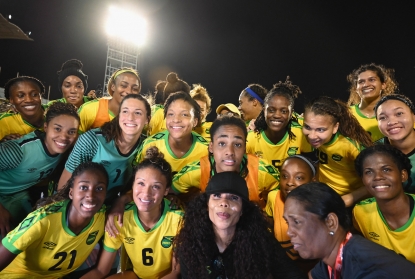 (AFP / Angela Weiss)
(AFP / Angela Weiss)
In New York, I cover so many different things all the time that I cannot really even recall what I did last week. So to focus on something so completely for even just a few days, and get to know those people, was wonderful.
After the red carpets, politics and a pandemic
This photo represents one of my first forays into political photography. It was 2016, on Election Night -- the night Donald Trump would win the US presidency. I was assigned to cover Hillary Clinton's campaign headquarters, and everyone really was convinced she would win. I stood in one little spot for 12 hours to be in the right place at the right time. I was picturing the confetti falling on her.
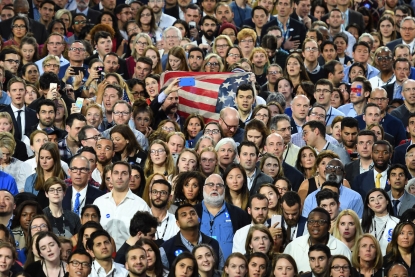 Democratic presidential nominee Hillary Clinton supporters watch the result unfold on a giant screen in New York on November 8, 2016 (AFP / Angela Weiss)
Democratic presidential nominee Hillary Clinton supporters watch the result unfold on a giant screen in New York on November 8, 2016 (AFP / Angela Weiss)
From my position behind the flags, I would have been able to capture her back as she gave her victory speech at the podium, facing the crowd. And then -- nothing but sad faces. Some cried. No confetti would fall. Clinton never appeared that night. That moment really hit me.
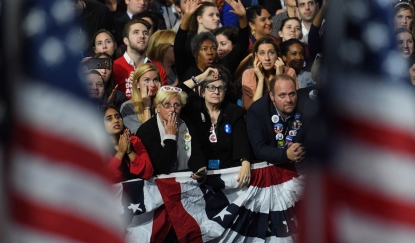 (AFP / Angela Weiss)
(AFP / Angela Weiss)
My life as a photographer changed when the coronavirus pandemic erupted. Eva, the deputy head of the photo desk in Washington, called me and said all the shows on Broadway were shutting down, and asked me to hustle to the Great White Way. I quickly understood that entertainment was going to vanish from our lives, and that things would change -- and I would need to adapt.
Two of the photographers on our team got Covid-19. I started riding my bicycle as taking the subway felt unsafe. There was nobody in the streets of New York. It was eerie. I rode across the Brooklyn Bridge to get to Manhattan. It was empty. I captured all these surreal moments.
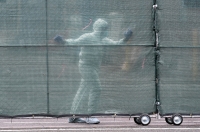
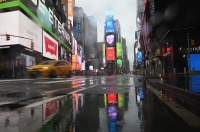

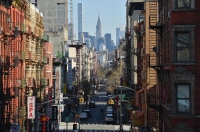
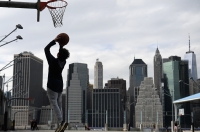
And then Joe Biden hit the presidential campaign trail. A few weeks before the November 2020 presidential election in the United States, I joined the press pool traveling with the Democratic candidate, who was running against Trump.
I felt a bit like an interloper, as most of the other people traveling with Biden have seemingly known each other for years, been shooting politics for years, and all of them lived in Washington. I'm based in New York. Covering a campaign requires a very particular skill set. Often you have very little time to set up for political events. You have to anticipate things before they happen. And you have to think outside the box. I learned on the fly.
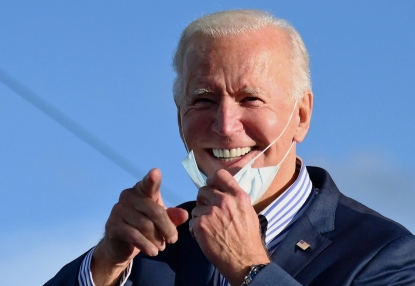 (AFP / Angela Weiss)
(AFP / Angela Weiss)
When the plane lands at the next campaign stop, everyone rushes out of the plane -- things happen really fast. You have no idea what is in store in terms of lighting, weather, etc. Then you have to board the plane, file quickly and do it again. And again. You have to be very alert.
I remember one stop in Pennsylvania, a key battleground state in the election, when all of a sudden, there were hundreds of Trump supporters on the motorcade's path. Only a few minutes later, the rally would be all pro-Biden.
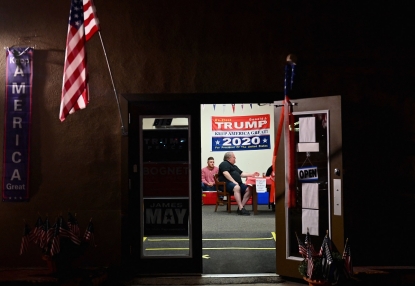 Trump supporters watch the first presidential debate between US President Donald Trump and Democratic presidential nominee and former Vice President Joe Biden on September 29, 2020 in Old Forge, near Scranton, Pennsylvania. (AFP / Angela Weiss)
Trump supporters watch the first presidential debate between US President Donald Trump and Democratic presidential nominee and former Vice President Joe Biden on September 29, 2020 in Old Forge, near Scranton, Pennsylvania. (AFP / Angela Weiss)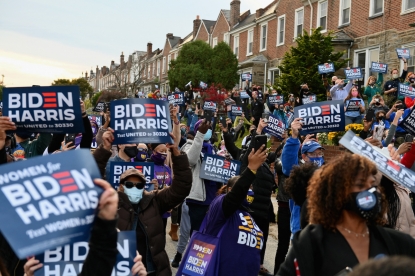 (AFP / Angela Weiss)
(AFP / Angela Weiss)
My years covering the Hollywood beat taught me how to react quickly. When a singer is jumping all around, you might have five photographers and all the pictures are different.
On Election Night 2020, AFP has three different positions at Biden's headquarters. One was right in front of the stage, and then the other two were on the sides. I was thinking we had a pretty bad spot, and that I would only be able to get his profile.
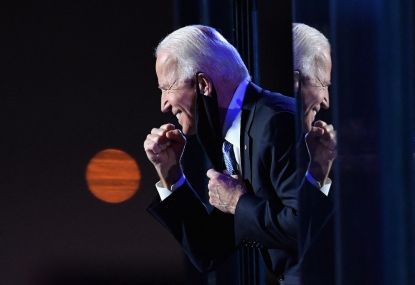 (AFP / Angela Weiss)
(AFP / Angela Weiss)And there were these glass barriers to boot. But then, at the end of his victory speech, I saw it happening -- he was moving to greet the crowd. There was light behind him and his reflection in the barrier. That picture made several front pages.
 (L-R) Doug Emhoff, US Vice President-elect Kamala Harris, incoming US First Lady Jill Biden, US President-elect Joe Biden arrive for the inauguration of Joe Biden as the 46th US President on January 20, 2021, at the US Capitol in Washington, DC. (Photo by (AFP / Angela Weiss)
(L-R) Doug Emhoff, US Vice President-elect Kamala Harris, incoming US First Lady Jill Biden, US President-elect Joe Biden arrive for the inauguration of Joe Biden as the 46th US President on January 20, 2021, at the US Capitol in Washington, DC. (Photo by (AFP / Angela Weiss)
Is it different being a woman photographer?
Photojournalism is still largely dominated by men. During Biden's campaign, we quickly realized that the pool had four women and two men. It was so surprising that we took a group photo! In Los Angeles, where it all started, most of the entertainment photographers were men -- a real boys' club.
The rare women I saw on the job were very competitive amongst themselves and worked very hard. They always went the extra mile to prove themselves. War reporting and urban unrest are two categories that essentially remain the territory of men. Fashion, red carpets -- you tend to see more women. I often ask myself why. Do people think these are things women cannot cover?
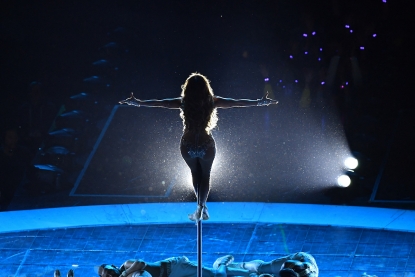 US singer Jennifer Lopez performs at the Hard Rock Stadium in Miami Gardens, Florida, on February 2, 2020 (AFP / Angela Weiss)
US singer Jennifer Lopez performs at the Hard Rock Stadium in Miami Gardens, Florida, on February 2, 2020 (AFP / Angela Weiss)
I don't think there is much different between men and women photographers. I mean, sometime, it may make a difference depending on the subject matter. A woman getting an abortion might feel more comfortable with a woman photographer, might feel that a woman would be more sensitive to the occasion. For something really testosterone heavy, men might wonder what I am doing there!
Of course, inevitably, there is a physical disadvantage for women, especially when you have to carry heavy equipment. But we've started using smaller and lighter gear.
I do have one story when being a woman made a difference. A lot of women covered the sex assault trial of Harvey Weinstein in New York. And I think I got one photo the men could not have taken.
 (AFP / Angela Weiss)
(AFP / Angela Weiss)
There were a bunch of us women who found a bathroom on the 16th or 17th floor of the building where the trial took place. And I leaned out the bathroom window with a long lens to get a picture of him walking in. I certainly got a different angle!
So what's next?
I think it would be nice to focus on certain stories for a bit longer. Maybe I could work on environmental stories -- climate change or something like that. Something really impactful.
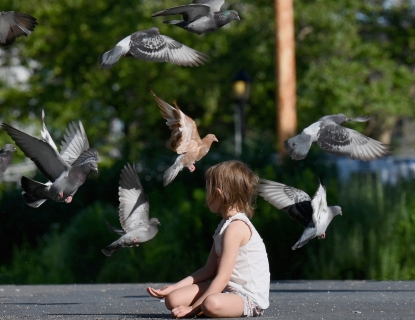 A child feeds pigeons at Battery Park on June 16, 2021 in New York City (AFP / Angela Weiss)
A child feeds pigeons at Battery Park on June 16, 2021 in New York City (AFP / Angela Weiss)Interview by Michaëla Cancela-Kieffer in Paris



